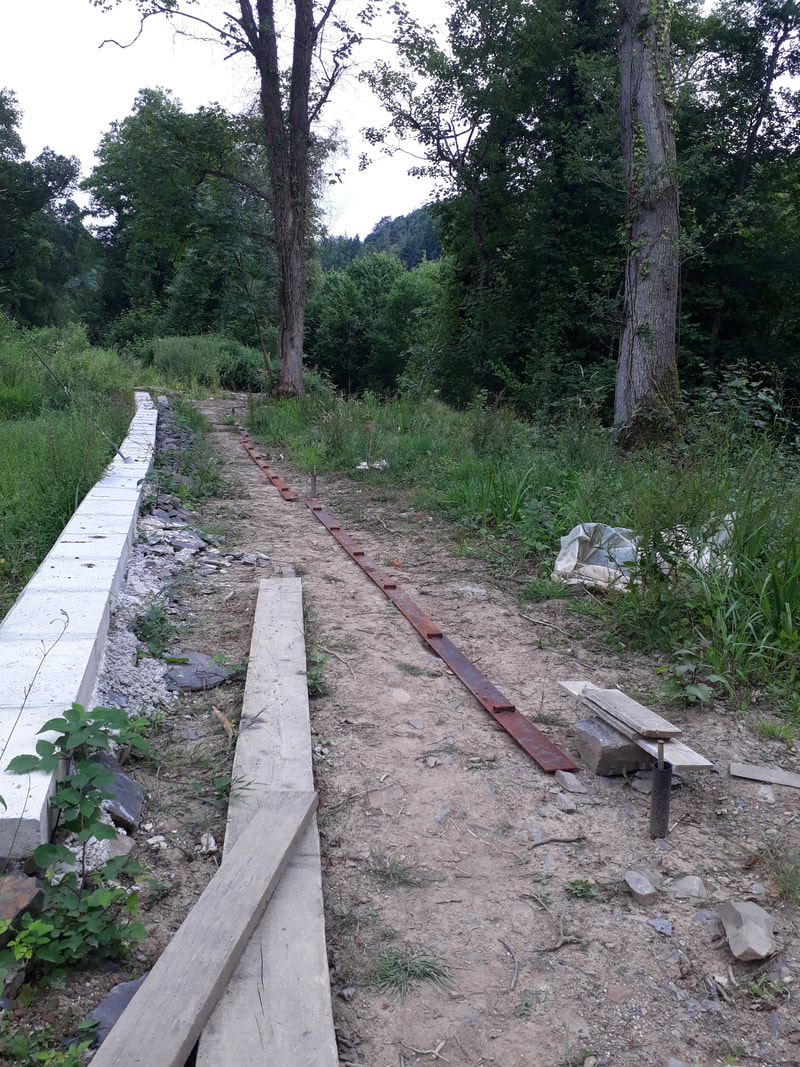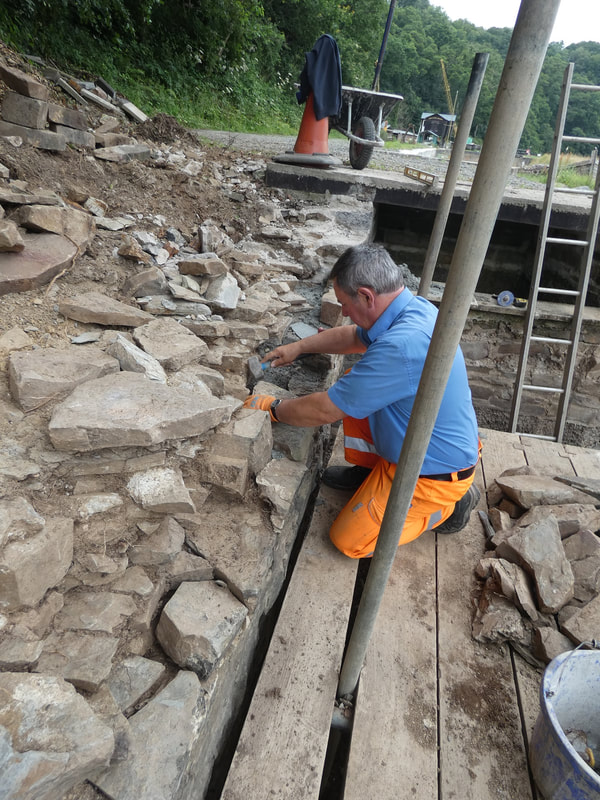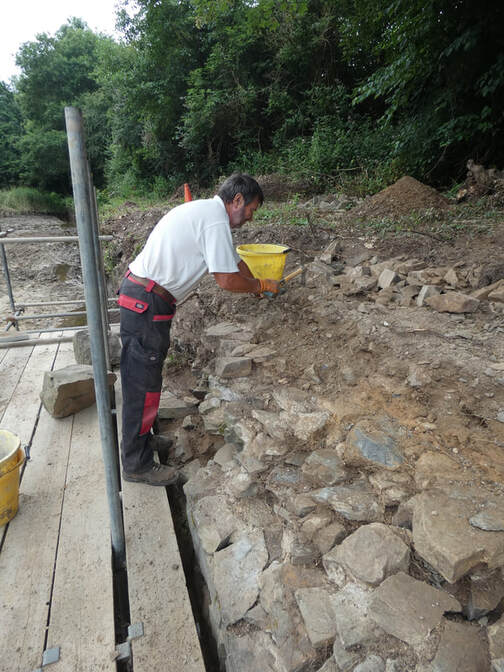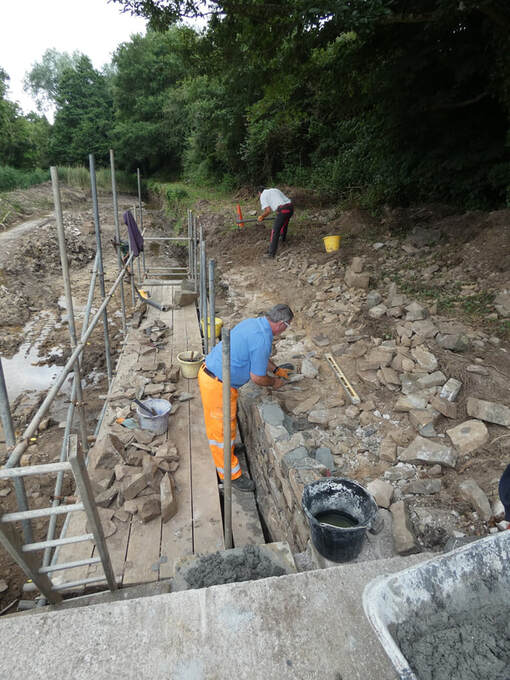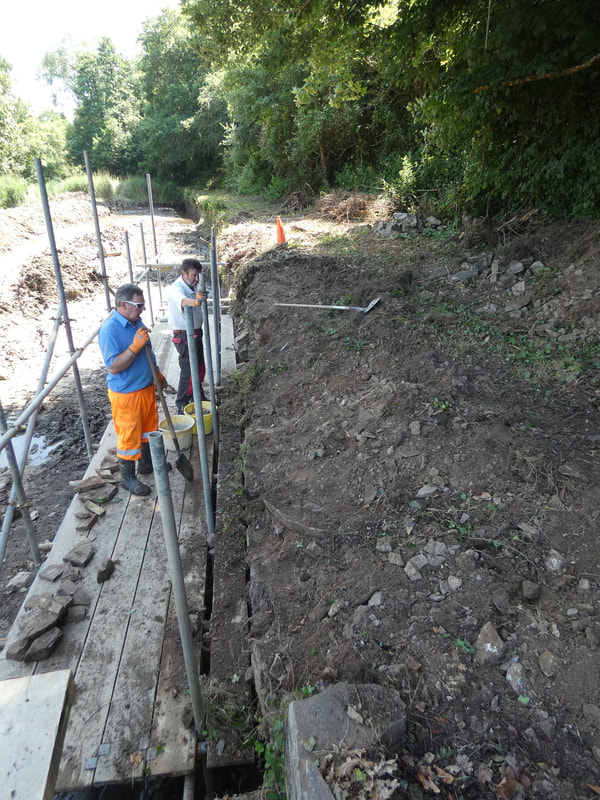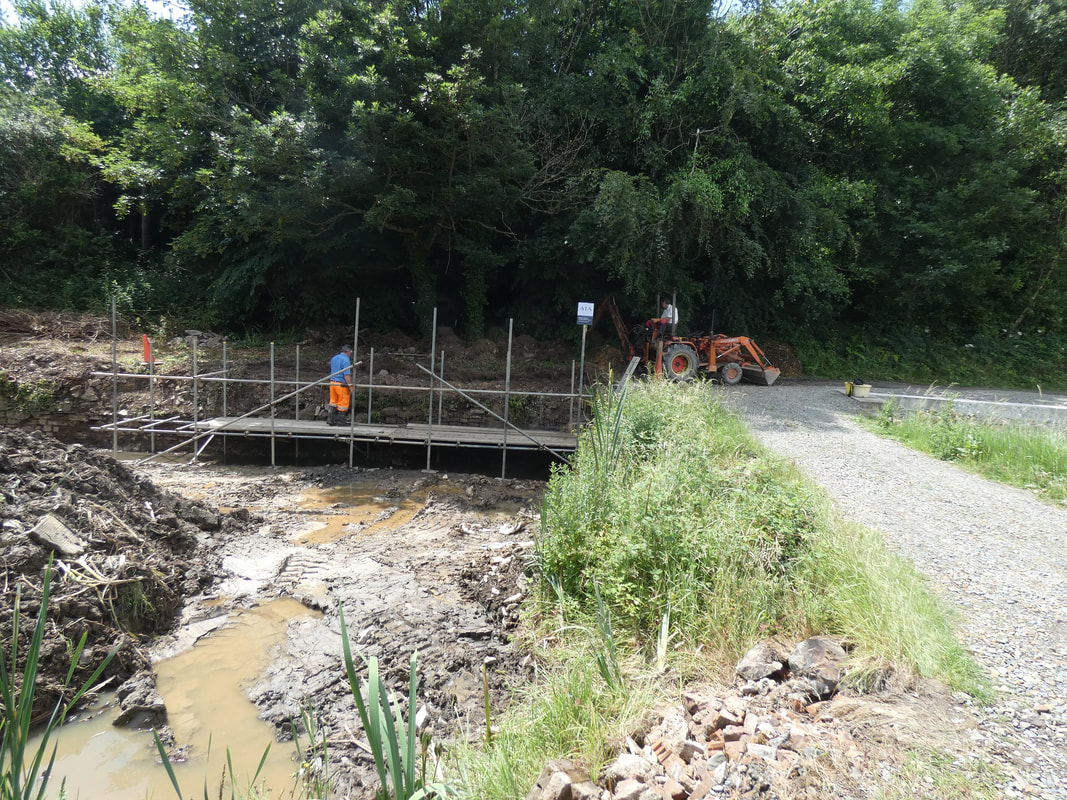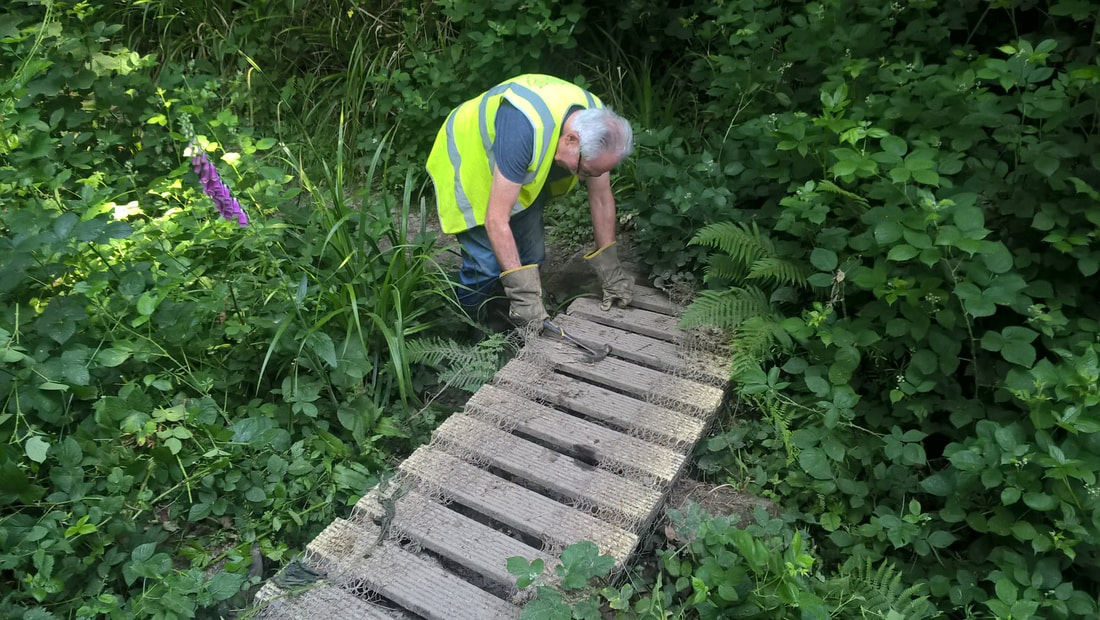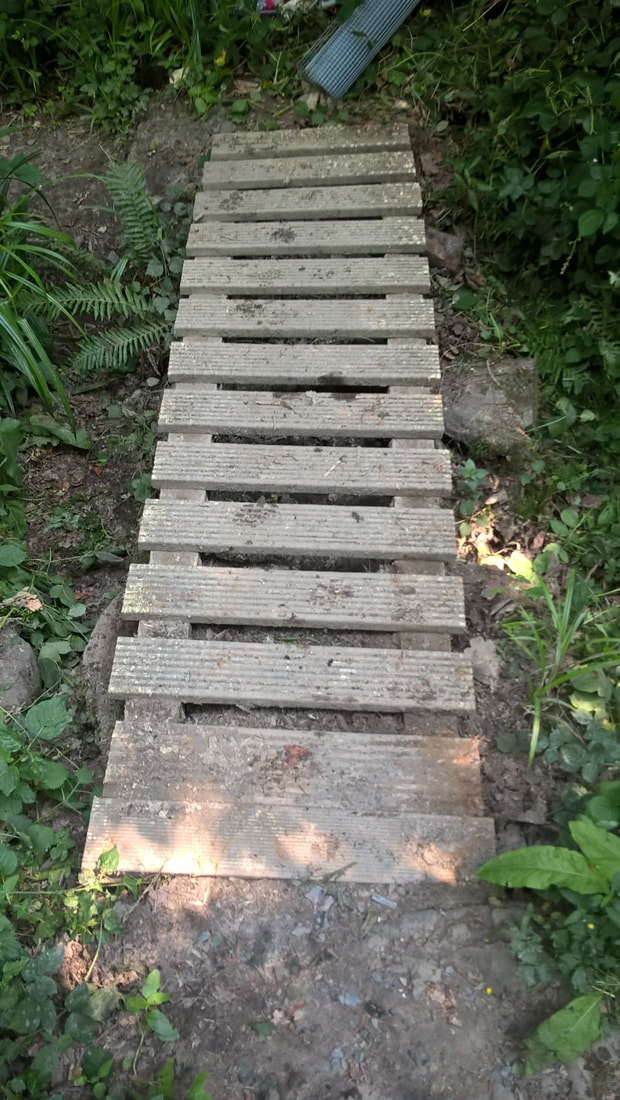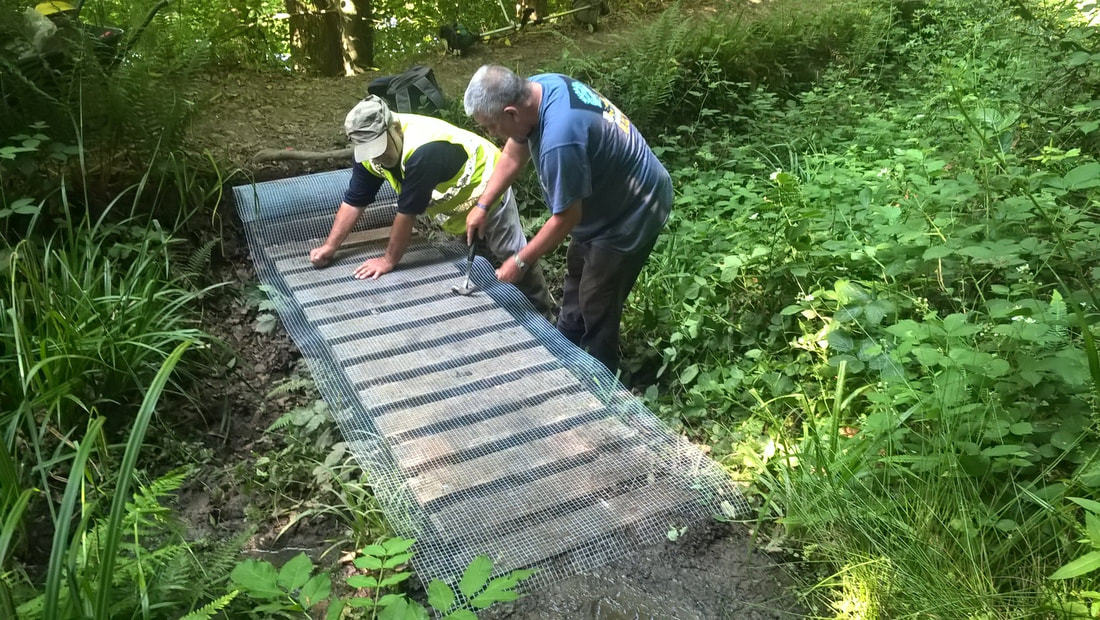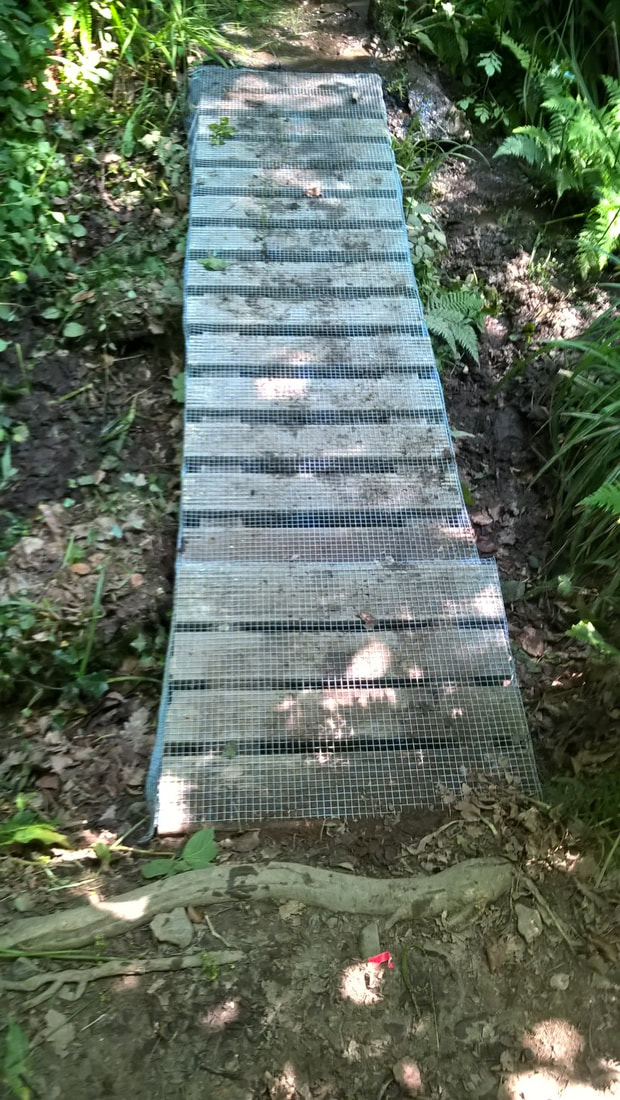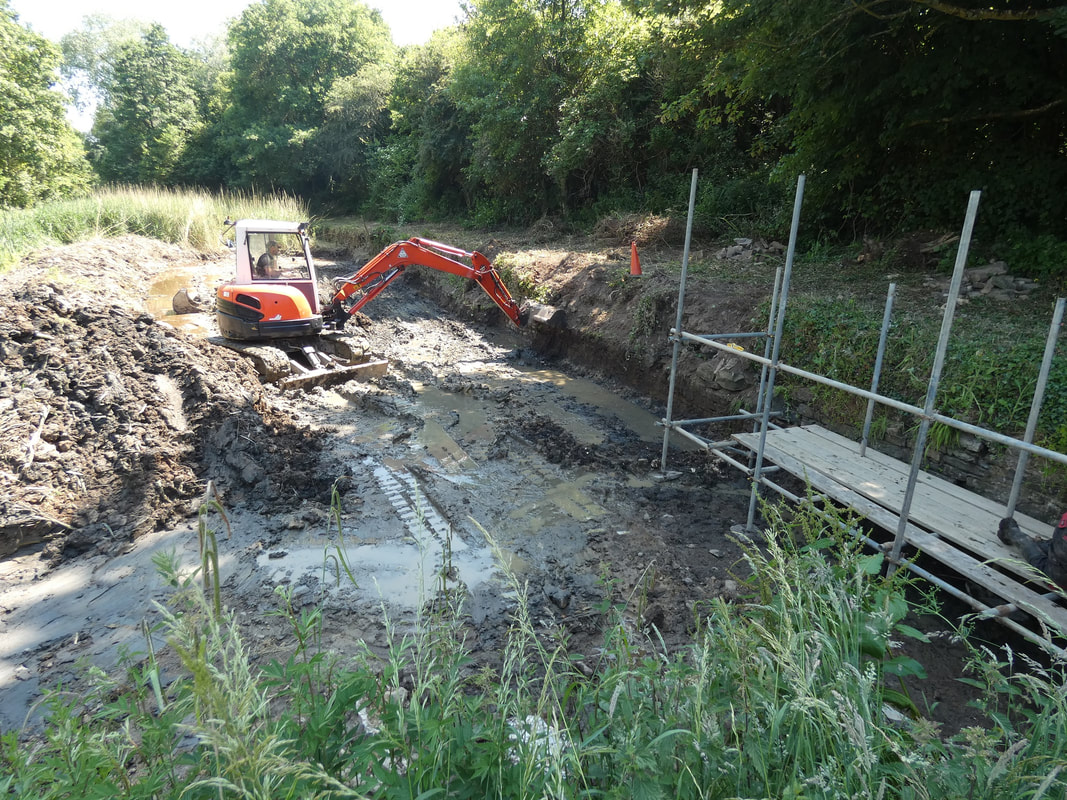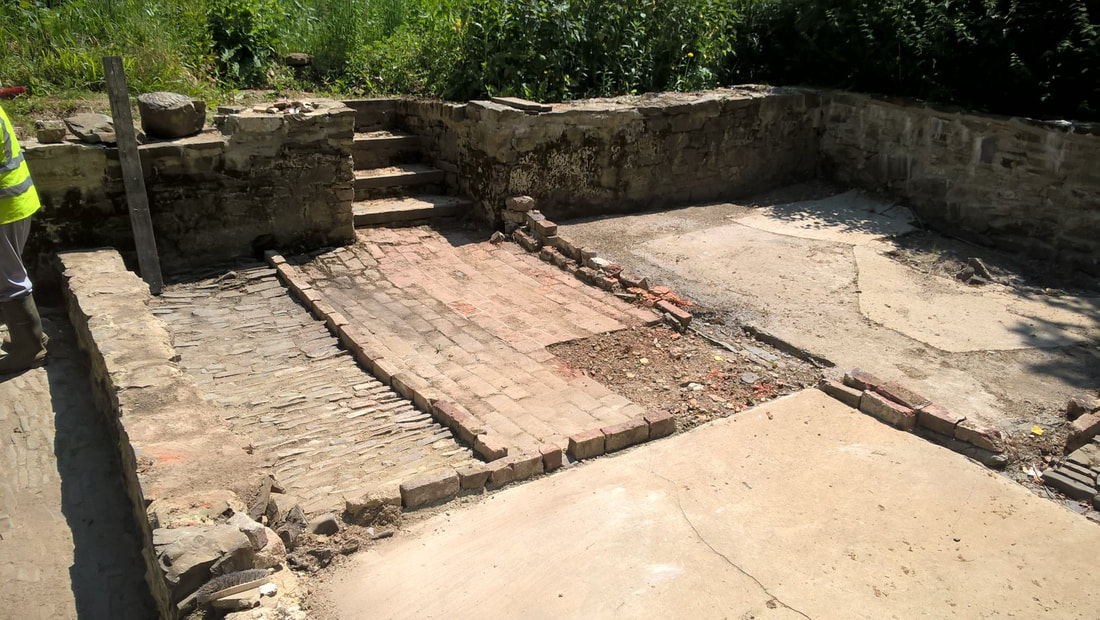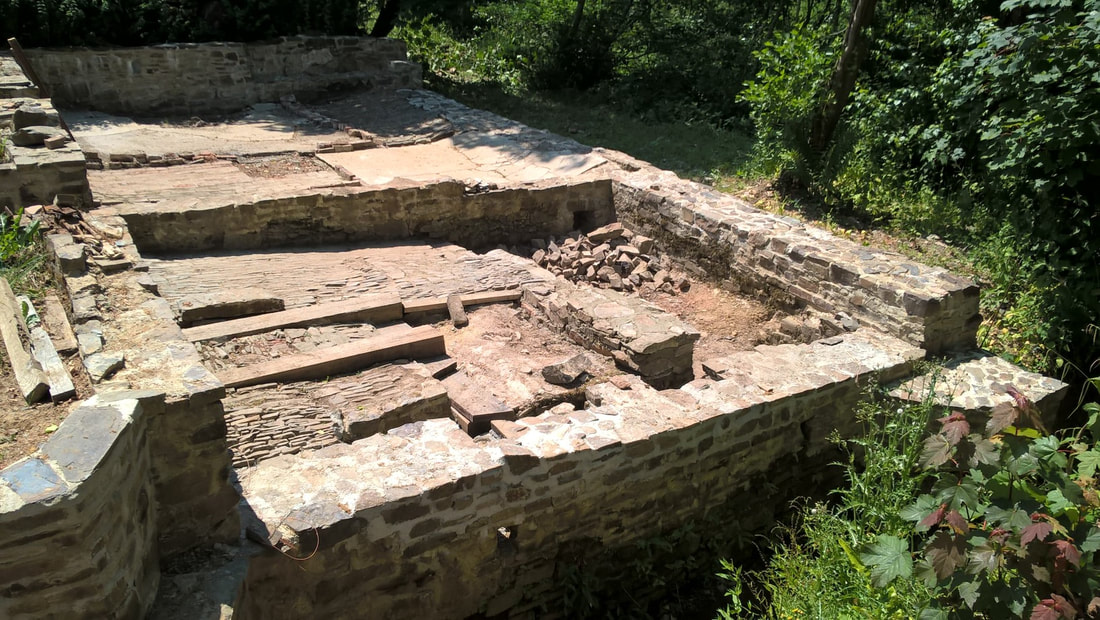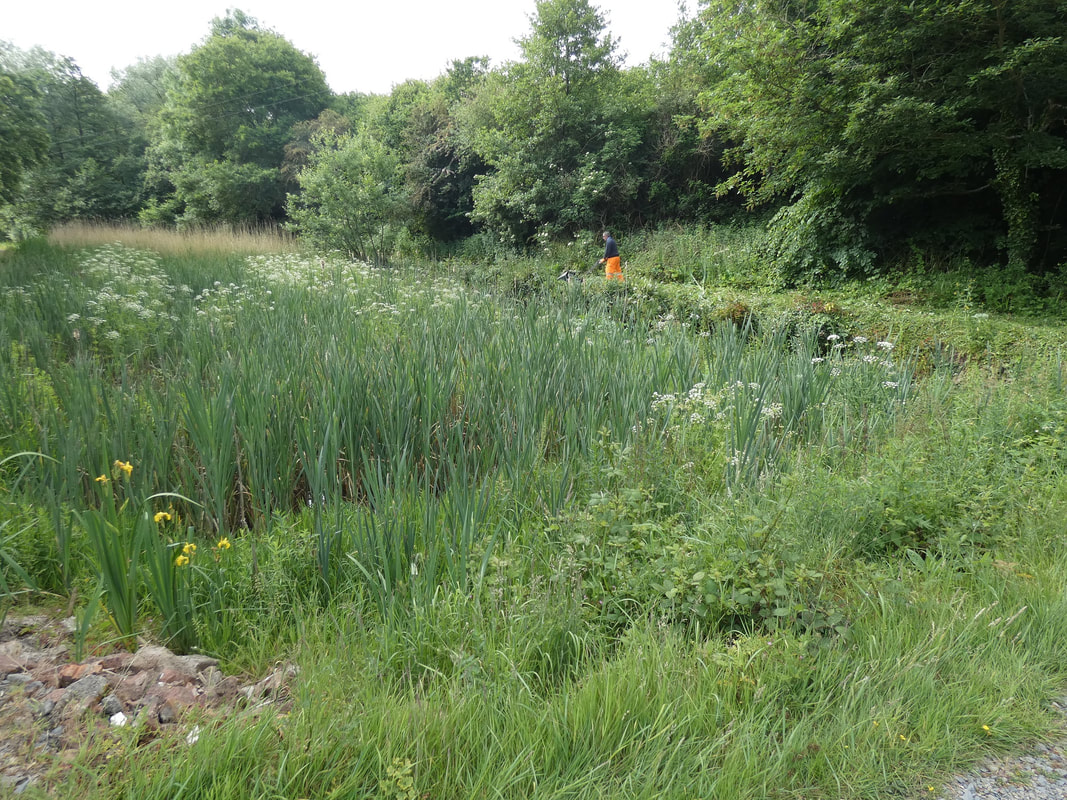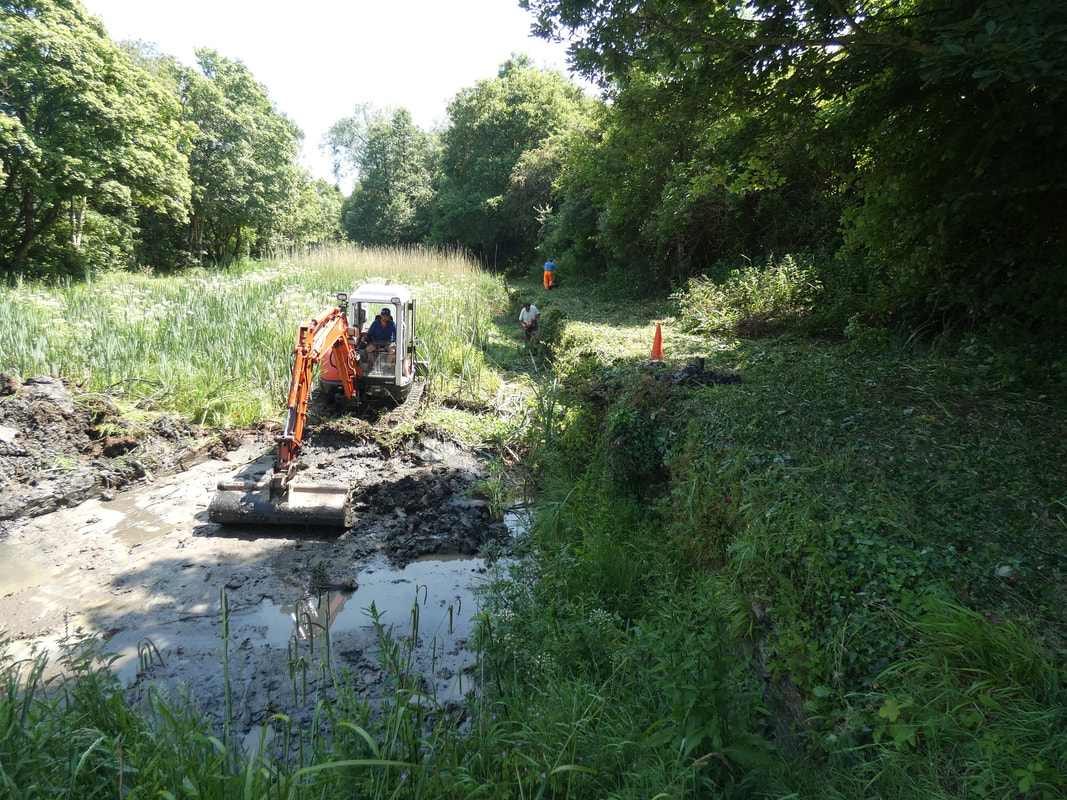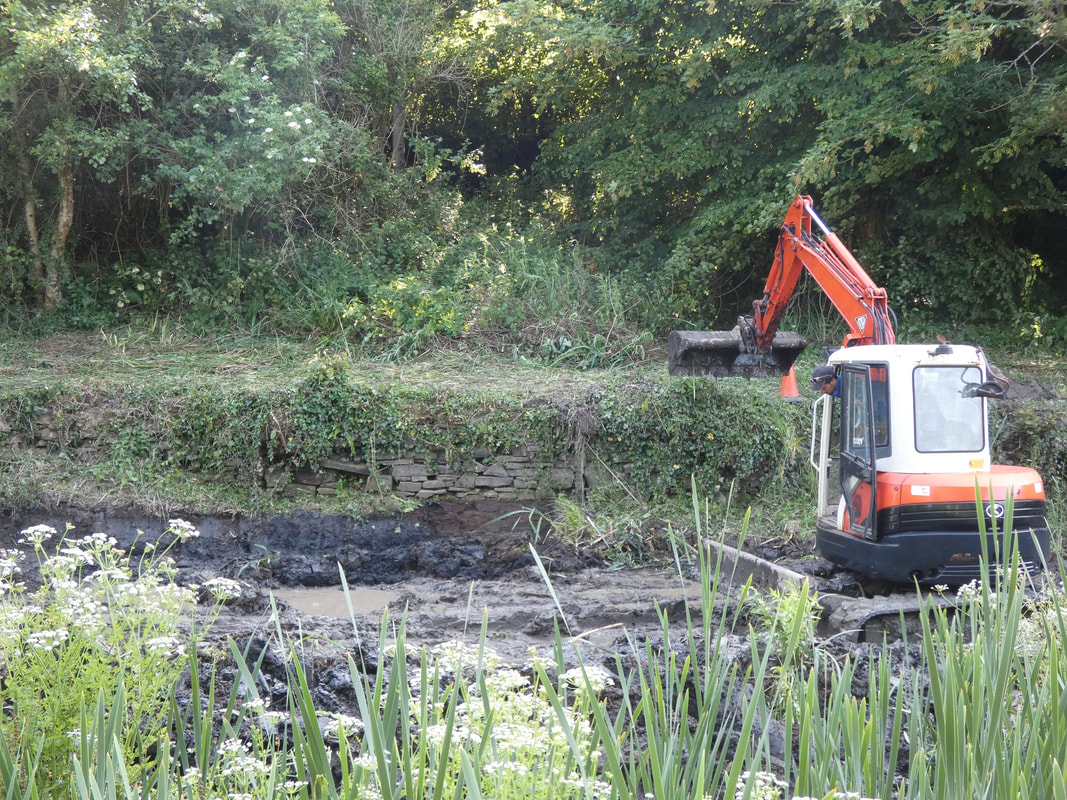June News
ROSEMOOR RESTORATION REPORT by Ian Harrison - 28th June 2023
This week we prepared the scaffolding for re-starting work on the big lime kiln arch and sorted and stockpiled stone ready for next week.
This week we prepared the scaffolding for re-starting work on the big lime kiln arch and sorted and stockpiled stone ready for next week.
We also carried out a bit more work on the tucking mill, detecting an irregular floor in the rear right-hand room which we think might represent some sort of soaking pit. We also got some steel strip to site in preparation for laying the new towpath between the tucking mill and the access track.
Work parties take place every Wednesday - all welcome!
Work parties take place every Wednesday - all welcome!
AS GOOD AS OLD? (Alternate title) GROUND HOG DAY - Sea Lock report from Adrian Wills - 28th June 2023
It was a cool and overcast start to Tuesday (27.06.23) with very light drizzle falling but good conditions for spending time out of doors. With only Steve, Nick and myself working at Sea Lock we still managed to make considerable progress on the upper wharf wall.
It was a cool and overcast start to Tuesday (27.06.23) with very light drizzle falling but good conditions for spending time out of doors. With only Steve, Nick and myself working at Sea Lock we still managed to make considerable progress on the upper wharf wall.
Having collected another 3-ton load of grit sand the day before enabled Steve to begin rebuilding part of the wall, which we had prepared earlier.
|
Nick started the day by re-establishing his relationship with the cement mixer and had quickly provided Steve with a barrowful of mortar. One slight problem with us working on the wall where we are is the distance between it and where the mixer, sand, cement, lime and tools are stored. This results in many ‘shunts’ of over 100 metres.
Once Steve had some mortar to work with, Nick and I continued the laborious process of removing soil and loose stonework further along the wall. Roots, which have penetrated the masonry, slow the process dramatically and are constant source of annoyance. Frequently when trying to remove them, stones are dislodged and have to be taken off the wall. It is certainly much quicker to demolish the wall than to rebuild it. However, by the end of the day, by which time the sun was shining and the temperature had risen considerably, much more wall had been cleared off and Steve had managed to rebuild quite a gap. |
Rebuilding the stonework but not completely grouting the gaps between the stones, has made the new built section look very similar to the best bits of the original build, which is very pleasing. Now, of course, this is sound and stable and should survive for another good few years.
|
Just by way of a change, we have now run out of suitable facing stone and hydraulic lime so a visit to the local quarry and builders’ merchants is next on the list.
GUIDED WALK – ROSEMOOR: The Dark Weir, Canal Basin and Limekilns – Sunday 25th June 2023
Starting from the end of the new extended car park at RHS Rosemoor Gardens near Great Torrington, this is an opportunity to walk beyond the public gardens through attractive woodland to Darkham Weir on the River Torridge from where the waters to feed the Rolle Canal were taken.
Then follow the Mill Leat to the recently cleared Canal Basin, effectively the terminus of the Rolle Canal. Here the old lime kilns can be seen as well as the foundations of a tucking mill. (Rosemoor operates a strict no dogs policy). Length about 2 and a half miles.
No booking is required – all are welcome. Please note that this walk includes private land where dogs are not permitted! A £2 donation will be requested towards the work of the Rolle Canal Society.
Meet at 2.30pm on Sunday 25th June at the far end of the RHS Rosemoor car park. The walk will be led by Michael Elliott.
Starting from the end of the new extended car park at RHS Rosemoor Gardens near Great Torrington, this is an opportunity to walk beyond the public gardens through attractive woodland to Darkham Weir on the River Torridge from where the waters to feed the Rolle Canal were taken.
Then follow the Mill Leat to the recently cleared Canal Basin, effectively the terminus of the Rolle Canal. Here the old lime kilns can be seen as well as the foundations of a tucking mill. (Rosemoor operates a strict no dogs policy). Length about 2 and a half miles.
No booking is required – all are welcome. Please note that this walk includes private land where dogs are not permitted! A £2 donation will be requested towards the work of the Rolle Canal Society.
Meet at 2.30pm on Sunday 25th June at the far end of the RHS Rosemoor car park. The walk will be led by Michael Elliott.
A VERDICT IS REACHED (Alternate title) Not So Dry Stoned! - Sea Lock report from Adrian Wills - 21st June 2023
The overcast and drizzly start to Tuesday morning (20.06.23), with a weather forecast of heavy rain to fall from 2.00pm onwards, did not bode well for working outside at Sea Lock that day. Never-the-less it was decided to give it a go and by the time Nick and Steve arrived at my house, just before 9.00am, the rain had stopped and the sky was clearing nicely. By the time we had walked to the site of Sea Lock the sun was shining and the air was warming rapidly.
The overcast and drizzly start to Tuesday morning (20.06.23), with a weather forecast of heavy rain to fall from 2.00pm onwards, did not bode well for working outside at Sea Lock that day. Never-the-less it was decided to give it a go and by the time Nick and Steve arrived at my house, just before 9.00am, the rain had stopped and the sky was clearing nicely. By the time we had walked to the site of Sea Lock the sun was shining and the air was warming rapidly.
It was decided to continue erecting scaffolding along the upper basin wall and clear the top of its overburden of invasive vegetation. The Kubota was needed for this task but that meant the grading bucket on the back hoe had to be swopped with a toothed digging bucket. This was quickly achieved but then it was discovered that the Kubota’s fuel tank was virtually empty as were the jerry cans which normally hold reserve fuel. Steve set about scavenging some from the tank of the RB crane by which time Michael and Tony had arrived. We continued the process of transporting scaffold paraphernalia over to where it was required and eventually Nick was able to start scraping off the top of the wall.
By lunchtime, a second stretch of scaffold lift had been constructed. Nick continued removing debris from the top of the wall whilst Steve and I began the tedious process of removing loose mortar and soil. This work did settle a debate in that it became apparent that when the wall was being constructed, [approximately 2 feet 6 inches wide (760 cms)] the stones were half-bedded on a very weak lime-based mortar but the gaps between them being left not grouted, making the wall appear to be dry-stone laid. The back of the wall was water-proofed by a thick coat, approximately 1 foot (30cms) wide of yellow clay as was used to line the base of the canal.
By 3.00pm, we had had enough. The predicted rain had not arrived and we had made very good process. Hopefully, reconstruction can begin very soon and, in the meantime, I need to start casting even more coping ‘stones’.
PS. Spot the new pair of sunglasses!
PS. Spot the new pair of sunglasses!
ROLLE CANAL REPORT - FURZEBEAM by Tony Nicholls - 14th June 2023
A small team of volunteers assembled at Furzebeam this week. There were two important jobs which we wanted to undertake – firstly to do some much needed strimming along the towpath; secondly, to replace the wire netting on the three wooden footbridges on the towpath. We have had a few complaints from dog owners that dogs have snagged their paws on broken wires so this was a task which needed our urgent attention.
A small team of volunteers assembled at Furzebeam this week. There were two important jobs which we wanted to undertake – firstly to do some much needed strimming along the towpath; secondly, to replace the wire netting on the three wooden footbridges on the towpath. We have had a few complaints from dog owners that dogs have snagged their paws on broken wires so this was a task which needed our urgent attention.
Stripping away the old wire
|
On reaching the roving bridge, we were dismayed to see how overgrown the canal had become in recent months. Last year we cut back a lot of the invasive vegetation around the bridge and got the site into a tidy condition so it was rather demoralising to see it in its current state. While one of the team started to clear the towpath, the rest started work stripping the old wire from the footbridges. This took a lot longer than we expected but eventually the old wire was removed and we then set about stapling the new wire in place. We managed to complete two of the bridges during the session and will finish the third next week. The new wire mesh we have used is sturdier and should last for several years. Footbridge with wire removed
|
Stapling the new wire in place
Footbridge with new wire mesh installed
|
We were surprised to see an interesting feature of the canal close to the roving bridge which is normally concealed – a sluice under a small stone arch. There were probably several of these at various points along the canal where ‘stop boards’ could be inserted in order to drain the canal when maintenance was needed. Given the fact that this little structure is some 200 years old, it is in remarkably good condition.
Working parties are held every Wednesday morning, meeting in the main car park at RHS Rosemoor, Torrington at 9.30am. Please contact Project Manager, Ian Harrison (tel.01237- 475707) for more information.
BACK TO SQUARE ONE? - Sea Lock report from Adrian Wills - 14th June 2023
It was another glorious day on Tuesday (13.06.23), bright sunny and dry. Just three of us working at Sea Lock initially, but we were later joined by Ryan, the digger driver.
Having cut down a great deal of invasive vegetation the previous week, we began preparing to erect some scaffolding along the face of the newly exposed wall. Nick brought out the Kubota tractor and with Steve acting as ’banksman’ giving him directions as to where to dig, he began pulling out some large tree stumps. Unfortunately, this created quite a bit of damage to the masonry but was a necessary ‘evil’.
It was another glorious day on Tuesday (13.06.23), bright sunny and dry. Just three of us working at Sea Lock initially, but we were later joined by Ryan, the digger driver.
Having cut down a great deal of invasive vegetation the previous week, we began preparing to erect some scaffolding along the face of the newly exposed wall. Nick brought out the Kubota tractor and with Steve acting as ’banksman’ giving him directions as to where to dig, he began pulling out some large tree stumps. Unfortunately, this created quite a bit of damage to the masonry but was a necessary ‘evil’.
While Nick operated the tractor’s backhoe, Steve later turned his attention to levelling places where concrete pads would be placed, on which the scaffold standards (uprights) were going to be positioned. I spent time sorting out scaffold boards, poles and clips, carrying them over to where they were needed.
|
Ryan drove his digger back down into the canal basin and continued to clear silt away from the wall, to make it easier to later erect more scaffolding further along it. By the end of the day, a short section of scaffolding had been successfully erected. Whilst there is now a great deal of soil and debris to be removed from the top of the wall before any sort of rebuilding can begin and a couple of quite large holes to be cleared out where the tree stumps had been removed, much of the wall appears to be in much better condition than we had originally thought. |
The jury is still out however, as to whether this section was dry-stone built or whether the stones were mortared into place. There is without a doubt a distinct lack of evidence of mortar as having been used, which seems most surprising! We will soon find out.
ROSEMOOR RESTORATION REPORT by Tony Nicholls - 7th June 2023
We pushed on with the restoration of the tucking mill this week as we are anxious to make the most of this fine spell of weather.
We pushed on with the restoration of the tucking mill this week as we are anxious to make the most of this fine spell of weather.
Work on the lower chamber
The outer walls are now complete so we have focussed on consolidating the interior of the building. This includes re-building the inner wall of the lower (west) chamber which was in a poor condition. There is a definite ‘pit’ in the lower corner of the chamber which we think may have housed a drain to allow waste water and material to be flushed out (in a very unenvironmentally-friendly way!) into the mill race. We also repaired a substantial area of damaged cobbles so the floor of the mill is now in a much better state, the new stones and the old blending well together. During the excavation of the mill, we uncovered several ‘grooves’ in the floor which were obviously the foundations of internal walls. We are laying a single course of bricks in these grooves to indicate the location of these walls. The restoration has really come on apace over the last few weeks and the key features of the mill can clearly be identified.
General view of the mill
Next week we will be at Furzebeam to carry out some much-needed scrub bashing around the roving bridge and along the tow path.
Working parties are held every Wednesday morning, meeting in the main car park at RHS Rosemoor, Torrington at 9.30am. Please contact Project Manager, Ian Harrison (tel.01237- 475707) for more information.
Working parties are held every Wednesday morning, meeting in the main car park at RHS Rosemoor, Torrington at 9.30am. Please contact Project Manager, Ian Harrison (tel.01237- 475707) for more information.
HERE WE GO AGAIN! - Sea Lock report from Adrian Wills - 7th June 2023
It has been quite some time since restorative work has been undertaken on the wharf walls at Sea Lock. The middle basin wall was successfully completed a while ago, thanks to a large extent to funding from AIA. Work to stabilize the interpretation loft has also been satisfactorily finished so on Tuesday (06.07.23) work began, with a vengeance, on the upper basin and its wall.
It has been quite some time since restorative work has been undertaken on the wharf walls at Sea Lock. The middle basin wall was successfully completed a while ago, thanks to a large extent to funding from AIA. Work to stabilize the interpretation loft has also been satisfactorily finished so on Tuesday (06.07.23) work began, with a vengeance, on the upper basin and its wall.
Employing a plethora of power driven and hand tools, the first task was to clear as much as possible of the ‘blanket of invasive vegetation from this section of wall. Steve got to grips with the Bolen Sickle Bar mower (a modern equivalent of the infamous Allen Scythe) and worked his way along the top of the wall while Nick used a long-reach chainsaw to remove overhanging branches. Tony followed up by dragging brash to where a chipper machine sat patiently waiting to be fed. Initially we were unable to start it because as certain person, possibly me, had left its ignition key at home. Another walk up and down the site was required. This machine was quickly fired up and happily reduced a large pile of branches to a slightly smaller but still quite significant pile of wood chips. All very noisy!
By midday most of the top of the wall was cleared of vegetation and the brash chipped up. Shortly after, the contractor previously employed, turned up with his 360º tracked excavator and with a very short time got ‘down and dirty’. At least his machine did. At long last we were able to get a good look at the face of the wall and appreciate just how much work was now required to restore it. At least ‘the dog could see the rabbit’ now!
We spent quite some time debating whether this section of wall was ever built using mortar or whether it was a simple dry-stone build. There is very little evidence of mortar showing between the stone courses but years of water leaching through the wall, exacerbated by the ingress of invasive vegetation, might well have washed it out. We will certainly use the same cement/ hydraulic lime /grit sand mortar mix as we used on the lower section when we get around to re-bedding stones here.
The next major task is to erect a new lift of scaffolding and begin the process of clearing roots from the wall and lifting off loose stones. It might take a while!


